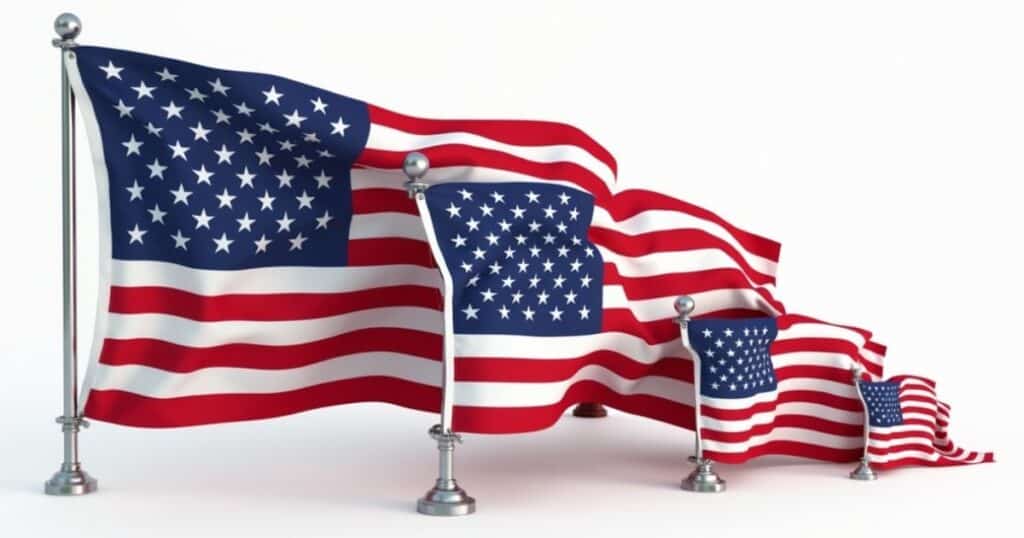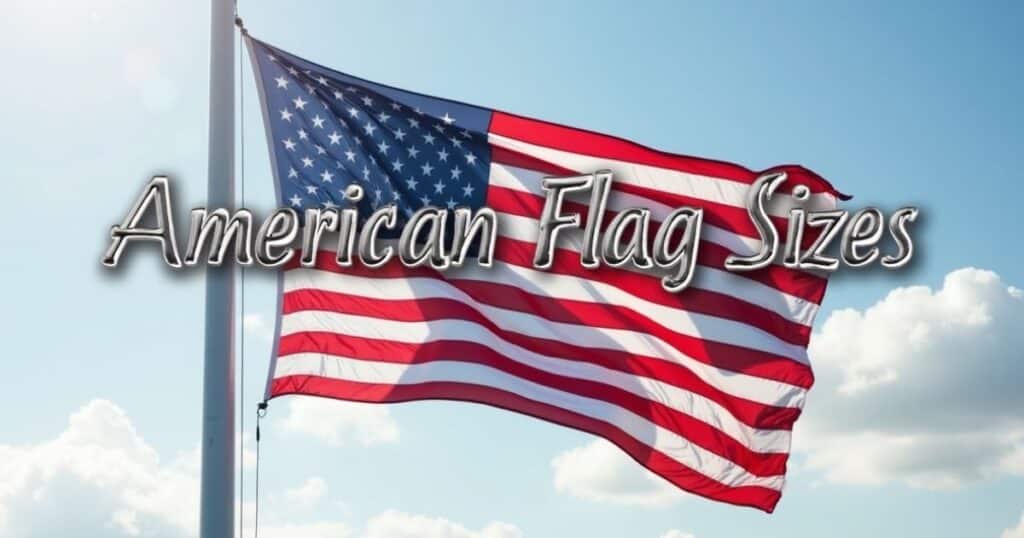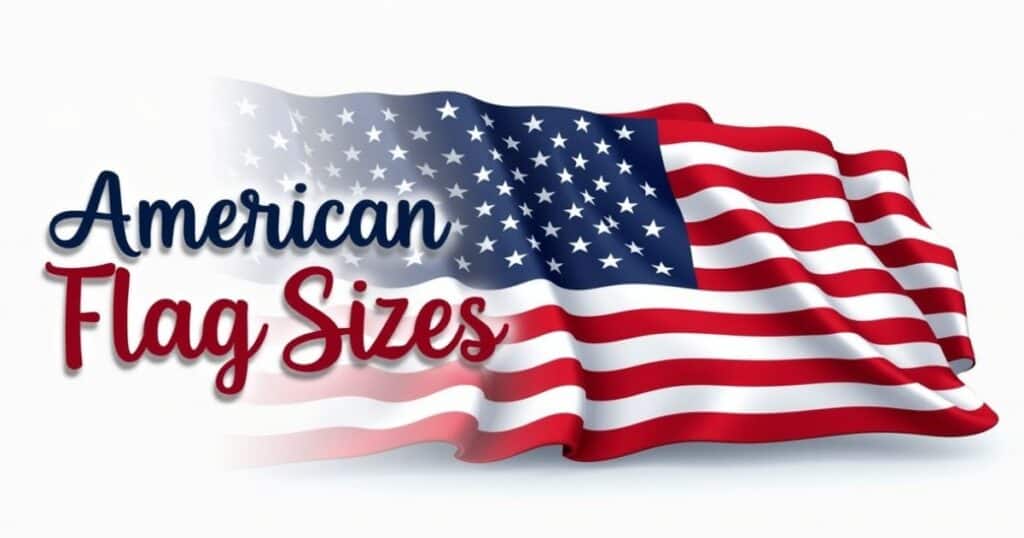Have you ever noticed how the American flag seems to appear in so many different sizes? From the tiny flags waving at parades to the massive banners hanging in stadiums, Old Glory comes in a remarkable variety of dimensions.
Yet each size serves a distinct purpose and carries its own significance. Whether you’re looking to purchase a flag for your home, planning a patriotic event, or simply curious about flag etiquette, understanding the various American flag sizes is both practical and fascinating.
Standard American Flag Sizes
The American flag comes in many standardized sizes, each designed for specific uses and settings. From the small hand-held versions to massive ceremonial flags, each dimension serves a purpose in displaying our national symbol.
Common Flag Sizes for Different Uses
The most common American flag sizes include:
- 3′ × 5′ – Standard residential flag
- 4′ × 6′ – Large residential flag
- 5′ × 8′ – Commercial/institutional use
- 8′ × 12′ – Large institutional display
- 10′ × 15′ – Stadium/large venue display
- 20′ × 30′ – Garrison flag (military use)
- 30′ × 60′ – Super garrison flag (special occasions)
Let’s explore these sizes in greater detail and understand when and where each is most appropriate.
Residential Flag Sizes
3′ × 5′ Flag: The Standard Home Flag
The 3′ × 5′ (three-foot by five-foot) flag stands as the most popular choice for American homeowners. This size strikes the perfect balance between visibility and practicality for most residential flagpoles.
This flag size works wonderfully on a standard 6-foot flagpole that extends from a house porch or wall. The proportion allows the flag to unfurl properly even in light wind without appearing oversized for the average home. When flying properly, this flag creates an impressive display that’s visible from the street without overwhelming your home’s façade.
Most flag manufacturers consider this size their standard residential flag, making it widely available and affordable. The 3′ × 5′ dimensions also adhere to the official flag proportion ratio of 1:1.9 (the width should be approximately 52% of the length).
Interesting fact: During World War II, many Americans displayed 3′ × 5′ flags in their windows or porches as symbols of support for troops overseas. This tradition helped cement this size as the standard for residential patriotic displays.
4′ × 6′ Flag: The Large Residential Option
For homeowners with taller flagpoles (typically 15-20 feet) in their yards, the 4′ × 6′ flag provides a more substantial presence. This slightly larger size creates a more commanding display while still being manageable for residential use.
The additional square footage makes this flag more visible from a distance, making it ideal for properties with larger yards or homes set back from the street. Despite its larger dimensions, a 4′ × 6′ flag remains lightweight enough for standard residential hardware to handle safely.
These flags work particularly well for homes with in-ground flagpoles that stand at approximately 20 feet tall. The proportionally larger flag creates a balanced visual presentation with taller poles.
Many homeowners choose this size when they want to make a more pronounced patriotic statement without moving into commercial-sized flags that might overwhelm a residential property.
Commercial and Institutional Flag Sizes
5′ × 8′ Flag: Small Business and Institutional Standard
The 5′ × 8′ flag represents the starting point for commercial and institutional flag displays. You’ll commonly find this size flying outside schools, small businesses, municipal buildings, and medium-sized venues.
This flag requires a substantial flagpole, typically 20-25 feet in height, to maintain proper proportion. The larger dimensions ensure visibility from greater distances, making it appropriate for public buildings where the flag serves as an official government display.
For many small businesses, this flag size strikes the ideal balance large enough to create a professional, authoritative appearance without the excessive cost of larger commercial options. The durability requirements for these flags typically increase as well, with heavier materials used to withstand constant outdoor display.
Schools often select this size because it provides excellent visibility across campus while still being manageable for daily raising and lowering ceremonies by staff or students. Many flag education programs in schools use the 5′ × 8′ flag as their primary teaching tool.
Interesting fact: The U.S. Flag Code doesn’t specify exact flag sizes but does establish the official proportions. The 5′ × 8′ size perfectly maintains these proportions while providing the visibility needed for public institutions.
8′ × 12′ Flag: Large Commercial Display
Moving up significantly in size, the 8′ × 12′ American flag creates a commanding presence appropriate for larger commercial properties, car dealerships, and significant institutional buildings. This impressive size requires a flagpole of approximately 40-50 feet.
These flags demand substantial hardware and durable construction to withstand the elements. The increased surface area creates significant wind load, requiring heavier-duty pole systems with larger pulleys and stronger halyards. Due to their size and the specialized equipment needed, these flags represent a significant investment.
You’ll often spot these massive flags at large car dealerships, department stores, and along highways at prominent businesses. The visibility factor increases dramatically an 8′ × 12′ flag can be seen clearly from considerable distances, making it an effective landmark and patriotic statement.
For many companies, displaying a flag of this size communicates permanence, stability, and American values. The impressive display often becomes part of a business’s visual identity within a community.
Did you know? Large flags of this size need to be lowered during severe weather events, as the wind resistance can damage both the flag and its mounting hardware. Professional flag services often assist businesses with the proper handling of flags this size.
Special Event and Military Flag Sizes
10′ × 15′ Flag: Stadium and Special Event Display
When attending professional sporting events or major public gatherings, you’ve likely witnessed the unfurling of massive 10′ × 15′ flags. These impressive displays require teams of people to handle properly and create breathtaking patriotic moments.
These flags typically appear horizontally rather than on traditional flagpoles. During national anthem ceremonies at professional sports games, dozens of people may hold these flags stretched out across fields or courts. The dramatic visual impact of these oversized flags creates powerful moments of national unity.
Given their specialized use, these flags often feature different construction than their smaller counterparts, with reinforced edges and handles to facilitate horizontal display. When not deployed for special ceremonies, storing these massive flags requires careful folding to prevent damage and dedicated storage space.
The cost of flags this size increases substantially often several hundred dollars and they represent a significant investment for organizations. However, the dramatic visual impact justifies the expense for many venues hosting high-profile events.
Interesting fact: For extremely large stadium displays, multiple 10′ × 15′ flags are sometimes sewn together to create truly massive presentations that can cover entire football fields!

20′ × 30′ to 30′ × 60′: Garrison and Super Garrison Flags
The military maintains special classifications for extremely large flags, with the “garrison flag” measuring an impressive 20′ × 30′ feet. Even more massive is the “super garrison flag” at a staggering 30′ × 60′ feet large enough to cover over 1,800 square feet!
These enormous flags appear at military installations on special national holidays and ceremonial occasions. The garrison flag represents the largest flag flown daily (in suitable weather) at Army posts, while the super garrison flag reserves its appearances for the most significant national holidays like Independence Day and Memorial Day.
Flying flags of this magnitude requires specially designed flagpoles reaching heights of 100 feet or more. The weight and wind resistance of these flags demand industrial-strength hardware and careful handling protocols. Military personnel receive specific training on properly raising, lowering, and folding these enormous symbols of national pride.
When folded in the traditional triangular pattern, these massive flags require teams of multiple service members working in perfect coordination. The resulting folded triangle can be several feet across far larger than the compact triangle of a standard residential flag.
Did you know? The largest free-flying American flag is flown in Sheboygan, Wisconsin, measuring an astounding 40′ × 70′ feet and weighing approximately 300 pounds when dry!
See Also: Graduation Cap Dimensions: Everything You Need to Know
Specialty and Indoor Flag Sizes
Miniature Flags: 4″ × 6″ to 12″ × 18″
Small hand-held flags play important roles in parades, classrooms, and patriotic celebrations. These miniature versions typically range from tiny 4″ × 6″ stick flags to slightly larger 12″ × 18″ models mounted on staffs.
Schools often use these smaller flags for classroom displays, Pledge of Allegiance ceremonies, and educational purposes. The manageable size makes them perfect for children to handle safely during patriotic events. During parades and celebrations, these easily portable flags create a sea of red, white, and blue when waved by crowds.
Despite their small size, properly made miniature flags still maintain the official proportions and design elements of their larger counterparts. Quality versions feature printed or embroidered stars rather than merely painted designs.
These small flags represent the most affordable option for displaying patriotic spirit, typically costing just a few dollars each. Their accessibility makes them perfect for community events and large-scale distributions.
Interesting fact: During presidential inaugurations, hundreds of thousands of these small flags often appear along the National Mall, creating iconic images of patriotic celebration visible in aerial photographs.
Indoor Ceremonial Flags: 3′ × 5′ to 4′ × 6′ with Fringe
Indoor ceremonial flags feature distinctive gold fringe around three sides and mount on decorative poles with ornamental spear or eagle finials. These formal flags appear in government offices, courtrooms, churches, and formal meeting spaces.
The gold fringe holds no official meaning according to the Flag Code but represents a longstanding tradition for indoor displays and formal settings. These flags typically feature high-quality materials like nylon or silk with rich, vibrant colors appropriate for close-up viewing.
Indoor ceremonial flags usually sit in floor stands or wall-mounted brackets rather than flying from traditional flagpoles. Their presence in official spaces symbolizes the authority of the government or organization and provides a formal backdrop for ceremonies and official functions.
Organizations from school boards to federal courts display these dignified versions of the flag as permanent fixtures in their meeting spaces. The carefully controlled indoor environment allows these flags to maintain their pristine appearance for many years with proper care.
Did you know? While the gold fringe has no official significance in the Flag Code, it has sparked numerous legal theories and myths. Courts have consistently ruled that fringed flags remain official national symbols despite conspiratorial claims to the contrary.
Flag Proportions and Design Elements
The Official Proportional Ratio: 1:1.9
While American flags come in various sizes, they should all maintain the official proportional ratio of 1:1.9 meaning the flag’s length should be approximately 1.9 times its height. This specific ratio creates the distinctive rectangular shape recognized worldwide.
The U.S. Flag Code establishes these proportions but allows for minor variations in commercial production. Deviating significantly from this ratio creates an immediately noticeable difference that can make a flag appear unofficial or improper.
This standardization ensures visual consistency whether you’re viewing a tiny hand-held flag or an enormous stadium display. The proportional harmony creates immediate recognition of our national symbol regardless of its physical dimensions.
When purchasing a flag, checking that it maintains these proper proportions provides one indicator of quality and authenticity. Reputable manufacturers adhere strictly to these specifications.
Star Field and Stripes: Maintaining Proper Scale
As flag sizes change, maintaining the proper scale and alignment of the 50 stars and 13 stripes becomes increasingly important. The blue field (union) should always occupy the upper left quarter of the flag, spanning 7 stripes in height.
The 50 stars arrange in 9 alternating rows (5 rows of 6 stars and 4 rows of 5 stars). As flag sizes increase, the individual stars grow proportionally larger while maintaining their precise arrangement. Modern manufacturing techniques, including digital printing and computer-controlled embroidery, help maintain consistency across different sizes.
The 13 alternating red and white stripes represent the original colonies, with red stripes at the top and bottom. Each stripe should maintain equal width regardless of the flag’s overall dimensions.
Did you know? The specific shade of red (PMS 193C) and blue (PMS 281C) are officially defined by the U.S. government to ensure consistency. However, older flags often show color variations due to different dye formulations used historically.

Choosing the Right Flag Size
Matching Flag Size to Pole Height
Selecting the appropriate flag size for your flagpole helps create a visually balanced display that honors the flag properly. Professional flag retailers recommend following these general guidelines:
- 20-foot pole: 3′ × 5′ or 4′ × 6′ flag
- 25-foot pole: 4′ × 6′ or 5′ × 8′ flag
- 30-foot pole: 5′ × 8′ flag
- 40-foot pole: 6′ × 10′ flag
- 50-foot pole: 8′ × 12′ flag
- 60-foot pole: 10′ × 15′ flag
- 100-foot pole: 20′ × 30′ or 30′ × 60′ flag
These proportions create a visually pleasing presentation while ensuring the flag can fly properly without touching the ground or becoming unmanageable in wind conditions.
For residential installations, it’s generally better to choose a slightly smaller flag that will fly consistently rather than an oversized flag that might become damaged or difficult to manage. The flag should occupy approximately one-quarter to one-third of the pole’s height for optimal visual impact.
See Also: Graduation Cap Dimensions: Everything You Need to Know
Wind Considerations and Durability
Larger flags catch significantly more wind, creating substantial loads on flagpoles and mounting hardware. When selecting a flag size, consider your local weather patterns and the flag’s location.
Areas with frequent high winds may require:
- Smaller flag sizes than the pole could otherwise accommodate
- Heavier-duty mounting hardware
- More durable flag materials like heavyweight nylon or polyester
- More frequent replacement schedules as wear accelerates
For particularly windy locations, consider using a “storm flag” a smaller version flown during inclement weather. Military installations officially use 5′ × 9.5′ storm flags during adverse conditions rather than their standard garrison flags.
Professional flag retailers can provide specific recommendations based on your local conditions and installation type. Investing in quality hardware and appropriate sizing prevents frustration and extends your flag’s lifespan considerably.
Practical Applications and Display Tips
Home Display Guidelines
When displaying the American flag at home, consider these practical guidelines:
- For attached house poles, the 3′ × 5′ flag generally provides the ideal balance of visibility and manageability.
- Ensure your mounting hardware can support your chosen flag size, particularly in windy conditions.
- Position your flag where it won’t become entangled with trees, power lines, or other obstacles.
- Install proper lighting if you plan to display your flag 24 hours a day (the Flag Code specifies flags should be illuminated if flown after sunset).
- Have a storage plan for your flag during severe weather events to prevent damage.
- Consider seasonal variations many homeowners use smaller flags during winter months when weather conditions are more severe.
For standalone residential poles, the height typically determines the appropriate flag size. A common 20-foot residential pole works well with either a 3′ × 5′ or 4′ × 6′ flag, depending on your preference and local wind conditions.
Special Events and Parades
For community events, consider these guidelines when selecting flag sizes:
- For parades, 3′ × 5′ flags on 8-foot staffs create an impressive display when carried by color guards or parade participants.
- For horizontal flag presentations across streets or buildings, specially designed “street flags” (typically 5′ × 8′ or larger) include reinforced edges and grommets for secure mounting.
- For memorial services, the standard 5′ × 9.5′ flag used for draping caskets has specific dimensions defined by military tradition.
- For commemorative events, consider having multiple flag sizes available smaller hand-held flags for participants and larger display flags as ceremonial focal points.
Working with a professional flag supplier can help ensure you have appropriate materials for your specific event needs. Many suppliers offer rental options for oversized flags needed only for special occasions.
Caring for Flags of Different Sizes
Storage Considerations
Proper storage extends your flag’s lifespan regardless of size:
- Small flags (up to 3′ × 5′) can be folded traditionally into triangular shapes and stored in protective boxes or display cases.
- Medium flags (5′ × 8′ to 8′ × 12′) should be folded loosely rather than creased sharply to prevent permanent fold lines and fiber damage.
- Large ceremonial flags (10′ × 15′ and larger) often require special storage equipment:
- Dedicated storage drums allow large flags to be rolled rather than folded
- Climate-controlled environments prevent mildew and color fading
- Acid-free tissue between layers protects colors from transferring
For any size flag, ensure complete dryness before storage to prevent mold and mildew damage. Professional flag services often provide specialized cleaning and storage for oversized flags beyond what homeowners can manage.
Cleaning Different Flag Materials
Cleaning methods vary based on both flag size and material:
- Small nylon or polyester flags (up to 3′ × 5′) can often be machine washed on gentle cycles with mild detergent, then air-dried.
- Medium-sized flags benefit from hand washing in cool water with mild soap, followed by air drying.
- Very large flags typically require professional cleaning services with specialized equipment.
- Cotton flags require special care regardless of size dry cleaning is often recommended rather than washing.
Always check manufacturer recommendations for your specific flag’s material before cleaning. Improper cleaning methods can cause color bleeding, fabric deterioration, or damage to embroidered elements.
Conclusion
Understanding American flag sizes helps you make appropriate choices for your specific display needs. Whether you’re outfitting your home with its first flag, selecting appropriate sizes for a business or institution, or planning a special patriotic event, choosing the right dimensions enhances both the flag’s appearance and longevity.
The American flag serves as our most recognizable national symbol, and displaying it with proper care and consideration honors its significance. From tiny parade flags waved by schoolchildren to massive garrison flags flying over military installations, each size plays an important role in our collective expression of patriotism.
Take a moment to look around your community and notice the variety of flag sizes on display. You’ll likely find examples ranging from small residential displays to impressive commercial installations, each appropriate to its specific context. This variety demonstrates how our national symbol adapts to diverse settings while maintaining its powerful symbolic presence.
Challenge yourself to identify the different flag sizes you encounter in daily life. With your new understanding of standard dimensions, you’ll develop a deeper appreciation for the thought and care that goes into proper flag displays throughout our nation.
Read more knowledgeable blogs on Measure Take.


